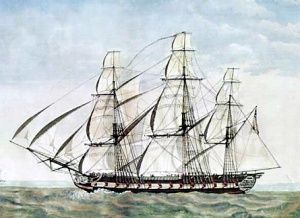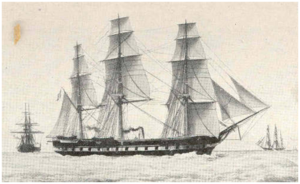Frigate
A frigate [frĭg'-ĭt] is a warship. The term has been used for warships of many sizes and roles over the past few centuries.
In the 18th century, the term referred to ships which were as long as a ship-of-the-line and were square-rigged on all three masts (full rigged), but were faster and with lighter armament, used for patrolling and escort.
HMS Reliant, William Laurence's command, is an example of a 36-gun frigate.
Origin
The term "frigate" originated in the Mediterranean in the late 15th century, referring to a lighter Galley type ship with oars, sails and a light armament, built for speed and maneuverability.
In 1583, during the Eighty Years' War, Habsburg Spain recovered the Southern Netherlands from the rebellious Dutch. This soon led to the occupied ports being used as bases for privateers, notably the Dunkirkers, to attack the shipping of the Dutch and their allies. To achieve this they developed small, maneuverable, sail-only vessels that came to be referred to as frigates. Because most regular navies required ships of greater endurance than the Dunkirker frigates could provide, the useful term 'frigate' was soon applied less exclusively to any relatively fast and elegant sail-only ship, such that much later even the mighty English Sovereign of the Seas was described as 'a delicate frigate' after modifications in 1651.
The navy of the Dutch Republic was the first regular navy to build the larger ocean-going frigates. The Dutch navy had three principal tasks in the struggle against Spain: to protect Dutch merchant ships at sea, to blockade the ports of Spanish-held Flanders to damage trade and halt enemy privateering, and to fight the Spanish fleet and prevent troop landings. The first two tasks required speed, shallowness of draft for the shallow waters around the Netherlands, and the ability to carry sufficient supplies to maintain a blockade. The third task required heavy armament, sufficient to fight against the Spanish fleet. The first of these larger battle-capable frigates were built around 1600 at Hoorn in Holland. By the later stages of the Eighty Years War the Dutch had switched entirely from the heavier ships still used by the English and Spanish to the lighter frigates, carrying around 40 guns and weighing around 300 tons.
The effectiveness of the Dutch frigates became most visible in the Battle of the Downs in 1639, triggering most other navies, especially the English, to adopt similar innovations.
The fleets built by the Commonwealth of England in the 1650s generally consisted of ships described as 'frigates', the largest of which were two-decker 'great frigates' of the third rate. Carrying 60 guns, these vessels were as big and capable as 'great ships' of the time; however, most other frigates at the time were used as 'cruisers': independent fast ships. The term 'frigate' implied a long hull design, which relates directly to speed (see hull speed) and also, in turn, helped the development of the broadside tactic in naval warfare.
In French, the term 'frigate' became a verb, meaning 'to build long and low', and an adjective, adding further confusion.
According to the rating system of the Royal Navy, laid down in the 1660s, frigates were usually of the fifth rate, though small 28-gun frigates were classed as sixth rate.
The classic frigate
The classic sailing frigate, well-known today for its role in the Napoleonic wars, can be traced back to French developments in the second quarter of the 18th century. The French-built Médée of 1740 is often regarded as the first example of this type. These ships were square-rigged and carried all their main guns on a single gun deck which replaced the upper gun deck on earlier similarly-sized two-decked ships. The lower deck, known as the "gun deck", now carried no armament, and functioned as a "berth deck" where the crew lived, and was in fact placed below the waterline of the new frigates. The new sailing frigates were able to fight with all their guns when the seas were so rough that comparable two-deckers had to close the gun-ports on their lower decks. Like the larger 74 which was developed at the same time, the new frigates sailed very well and were good fighting vessels due to a combination of long hulls and low upperworks compared to vessels of comparable size and firepower.
The Royal Navy captured a handful of the new French frigates during the early stages of the Seven Years' War (1756–1763) and were impressed by them, particularly for their inshore handling capabilities. They soon built copies and started to adapt the type to their own needs, setting the standard for other frigates as a superpower.
Royal Navy frigates of the late 18th century were based on the 1780-vintage Perseverance class, which displaced around 900 tons and carried 36 guns; this successful class was followed by the Tribune class batch of fifteen ships starting in 1801 that displaced over 1,000 tons and carried 38 guns.
In 1797, the US Navy's first major ships were 44-gun frigates (or "super-frigates"), which actually carried fifty-six to sixty 24-pounder long guns and 36-pounder or 48-pounder carronades on two decks, and were exceptionally powerful and tough. These ships were so well-respected that they were often seen as equal to 4th-rate ships of the line and, after a series of losses at the outbreak of the War of 1812, British Royal Navy fighting instructions ordered British frigates (usually of 38-guns or less) to never engage American frigates at any less than a 2:1 advantage. The USS Constitution, better known as "Old Ironsides", the oldest commissioned ship afloat, is the last remaining example of an American 44.
The role of the frigates
Frigates were perhaps the hardest-worked of warship types during the age of sail. While smaller than a ship-of-the-line, they were formidable opponents for the large numbers of sloops and gunboats, not to mention privateers or merchantmen. Able to carry six months' stores, they had very long range; and vessels larger than frigates were considered too valuable to operate independently.
Frigates scouted for the fleet, went on commerce-raiding missions and patrols, conveyed messages and dignitaries. Usually frigates would fight in small numbers or singly against other frigates. They would avoid contact with ships-of-the-line; even in the midst of a fleet engagement it was bad etiquette for a ship of the line to fire on an enemy frigate which had not fired first.
For officers in the Royal Navy a frigate was a desirable posting. Frigates often saw action, which meant a greater chance of glory, promotion, and prize money.
Unlike larger ships that were placed in ordinary, frigates were kept in service in peacetime as a cost-saving measure and to provide experience to frigate captains and officers which would be useful in wartime. Frigates could also carry marines for boarding enemy ships or for operations on shore.
Frigate armament ranged from 22 guns on one deck to up to even 60 guns on two decks. Common armament was 32 to 44 long guns, from 8 to 24 pounders (3.6 to 11 kg), plus a few carronades (large bore short range guns).

